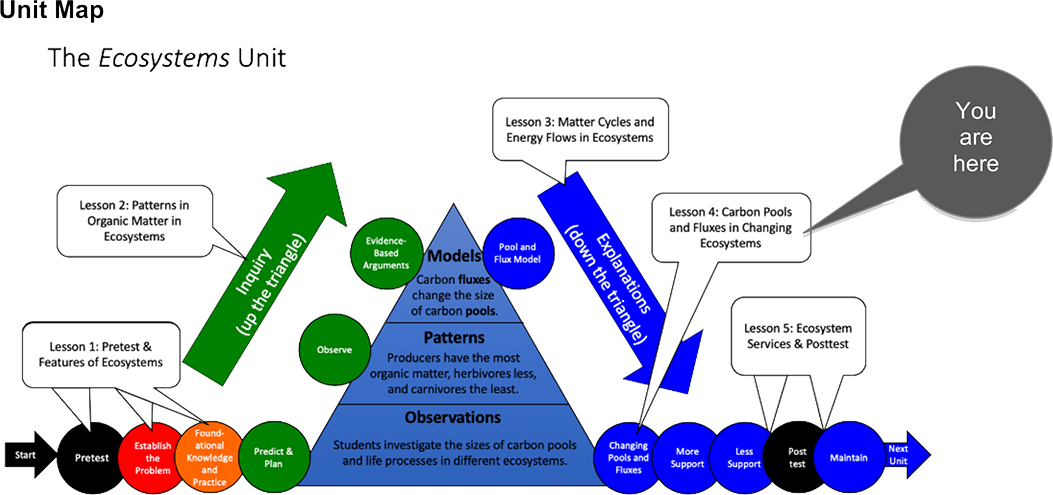Transformations in Matter and Energy Carbon TIME is an NSF-funded partnership led by Michigan State University
Lesson 4: Carbon Pools and Fluxes in Changing Ecosystems
 Overview
Overview
NOTE: This lesson introduces a quantitative model of carbon pools and fluxes, then uses that model to explain how ecosystems change over time. This is challenging content that addresses NGSS High School Performance Expectations. You may want to skip it with middle school classes.
In Lesson 2, students identified the pattern of organic matter distribution (the organic matter pyramid) in a meadow ecosystem. In Lesson 3, they explained why that pattern exists by tracing matter and energy and connecting scales. In Lesson 4, students explain changes in ecosystems by keeping track of carbon pools and carbon fluxes. Carbon fluxes are the rates (mass/time) at which carbon transforming processes occur.
Guiding Question
How and why do carbon pools in ecosystems change over time?
Activities in this Lesson
- Activity 4.1: Tiny Pool and Flux Game (30 min)
- Activity 4.2: Carbon Pools and Constant Flux Simulation (30 min)
- Activity 4.3: How Fluxes Change and Photosynthesis Limits (40 min)
- Activity 4.4: Seasonal Changes and Ecosystem Disturbances (40 min)
Unit Map

Target Student Performance
|
Activity |
Target Performance |
|
|
|
|---|---|
|
Activity 4.1: Tiny Pool and Flux Game |
Students describe the relationship between pools and fluxes in a physical model: changes in pool sizes depend on balance among fluxes. |
|
Activity 4.2: Carbon Pools and Constant Flux Simulation |
Students describe the relationship between pools and fluxes in an online computer model: changes in pool sizes depend on balance among fluxes. |
|
Activity 4.3: How Fluxes Change and Photosynthesis Limits |
Students use an online computer model to describe how changes in carbon pools over time depend on the maximum possible rate of photosynthesis in an ecosystem. |
|
Activity 4.4: Seasonal Changes and Ecosystem Disturbances |
Students use an online computer model to describe how seasons and disturbances affect an ecosystem. |
NGSS Performance Expectations
High School
- Chemical Reactions. HS-PS1-7. Use mathematical representations to support the claim that atoms, and therefore mass, are conserved during a chemical reaction.
- Ecosystems: Interactions, Energy, and Dynamics. HS-LS2-1. Use mathematical and or computational representations to support explanations of factors that affect carrying capacity of ecosystems at different scales.
- Ecosystems: Interactions, Energy, and Dynamics. HS-LS2-2. Use mathematical representations to support and revise explanations based on evidence about factors affecting biodiversity and populations in ecosystems at different scales.
- Ecosystems: Interactions, Energy, and Dynamics. HS-LS2-4. Use mathematical representations to support claims for the cycling of matter and flow of energy among organisms in an ecosystem.
- Ecosystems: Interactions, Energy, and Dynamics. HS-LS2-5: Develop a model to illustrate the role of photosynthesis and cellular respiration in the cycling of carbon among the biosphere, atmosphere, hydrosphere, and geosphere.
- Ecosystems: Interactions, Energy, and Dynamics. HS-LS2-6: Evaluate claims, evidence, and reasoning that the complex interactions in ecosystems maintain relatively consistent numbers and types of organisms in stable conditions, but changing conditions may result in a new ecosystem.
- Earth’s Systems. HS-ESS2-6. Develop a quantitative model to describe the cycling of carbon among the hydrosphere, atmosphere, geosphere, and biosphere.
Middle School
- Matter and Energy in Organisms and Ecosystems. MS-LS2-1. Analyze and interpret data to provide evidence for the effects of resource availability on organisms and populations of organisms in an ecosystem.
- Interdependent Relationships in Ecosystems. MS-LS2-2. Construct an explanation that predicts patterns of interactions among organisms across multiple ecosystems.
- Matter and Energy in Organisms and Ecosystems. MS-LS2-3. Develop a model to describe the cycling of matter and flow of energy among living and nonliving parts of an ecosystem.
- Matter and Energy in Organisms and Ecosystems. MS-LS2-4. Construct an argument supported by empirical evidence that changes to physical or biological components of an ecosystem affect populations.
- Matter and Energy in Organisms and Ecosystems. MS-LS1-6. Construct a scientific explanation based on evidence for the role of photosynthesis in the cycling of matter and flow of energy in and out of organisms.
- Earth’s Systems. MS-ESS2-1. Develop a model to describe the cycling of earth’s materials and the flow of energy that drives this process.
- Human Impacts. ESS3-4. Construct an argument supported by evidence for how increases in human population and per-capita consumption of natural resources impact Earth’s systems.

 Download PDF of Lesson 4 Teacher's Guide
Download PDF of Lesson 4 Teacher's Guide